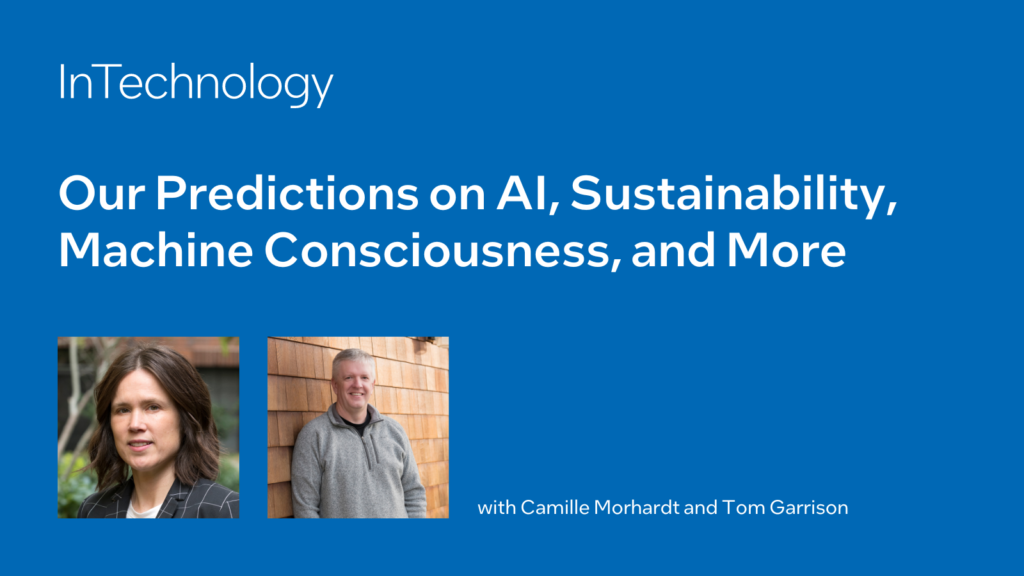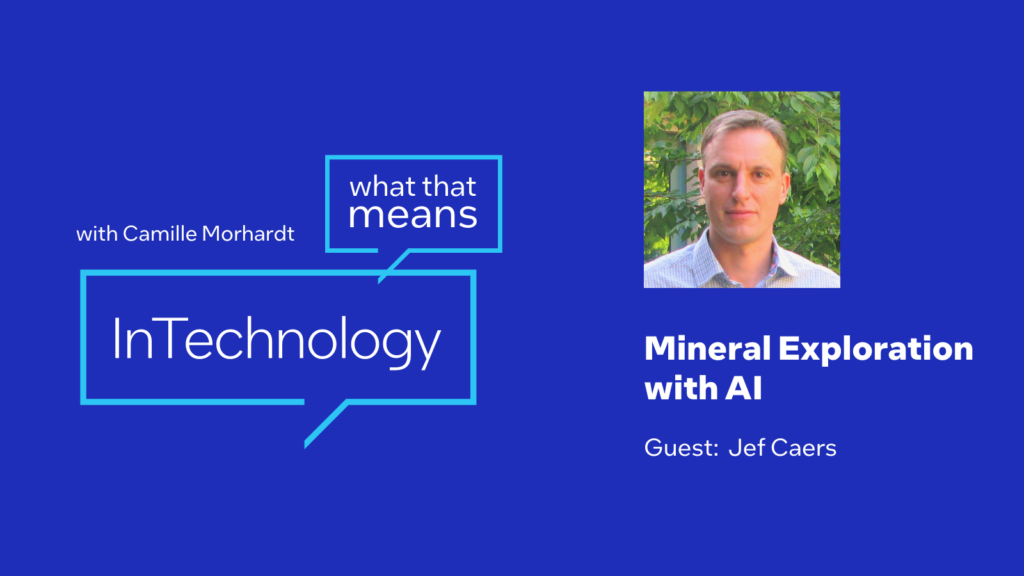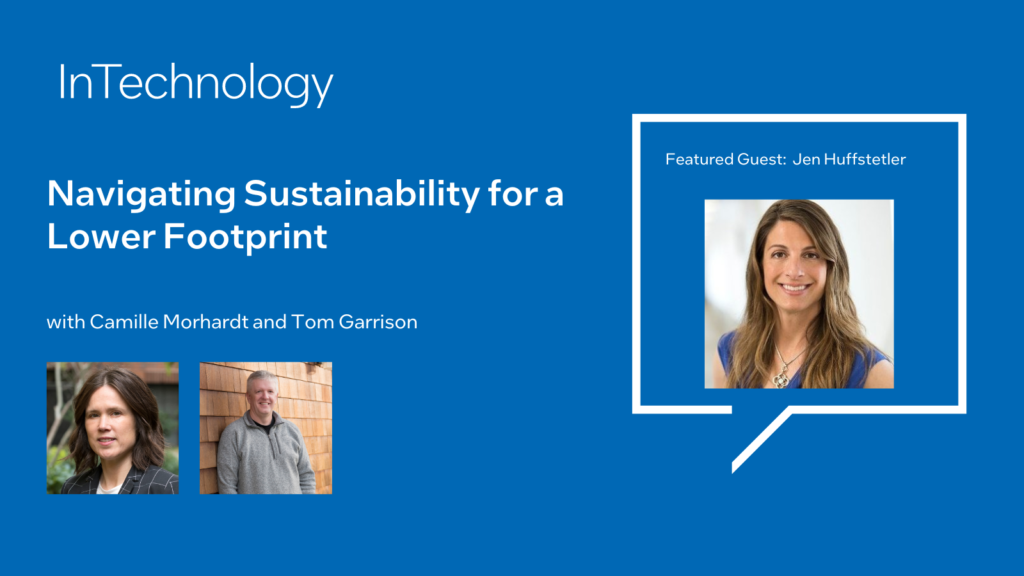[00:00:37] Camille Morhardt: I’m very excited to cover What That Means, Sustainable Compute with Michelle Chuaprasert. She’s a senior Director of Sustainable Compute. She’s actually responsible for the Client Sustainability Roadmap and strategy, and she’s also co-lead for an initiative across Intel that I will ask her a little bit about, it’s the Carbon Neutral Global Challenge Working Group, which is internal to Intel, but something she’s co-leading. Welcome to the podcast, Michelle.
[00:01:05] Michelle Chuaprasert: Thank you so much, Camille. So glad to be here.
[00:01:08] Camille Morhardt: So we’re on What That Means. And this is very easy for me because I’m relatively new to this sustainability topic. Can you define what is “sustainability” and then define what is “compute” so that we can then put the two together and understand what is sustainable compute.
[00:01:28] Michelle Chuaprasert: Sustainability in terms of a PC, I would think about the emissions or the equivalent carbon emissions across the life cycle of the PC. It’s all about what emissions you had in the manufacture and the operation of the PC. Then thinking about what happens at the end of life, does it get traded in? Does it get recycled or what sustainable thing happens? That’s how I think about the sustainability. Compute’s an interesting question. What does compute mean for a PC? I think I would define it as how much work a PC can do that the user wants done.
[00:02:07] Camille Morhardt: Very succinct, thank you. Possibly the most succinct definition I’ve ever gotten on this show. You went through the life cycle for a computer from, I think what you said was build, operate…. Was there a third one?
[00:02:23] Michelle Chuaprasert: It’s the manufacture, the operation, and then the end of life, and so recycling or refurbishing.
[00:02:29] Camille Morhardt: Okay, I was gonna ask which one is the most carbon footprint intensive, but onviously isn’t part of that equation. Is it the building and that entire sourcing and process, extraction, et cetera, or is it the actual running of the PC?
[00:02:45] Michelle Chuaprasert: That is such a great question. It varies on whether it’s a notebook computer, a desktop computer, or a server. A server is a whole different story. If you look at the client PC, you see a notebook computer, usually about 85% in the manufacture. And it’s only about 15% during the operation. However, a desktop PC is different. A desktop is closer to 50 – 50 as far as the operation versus the manufacture of it.
[00:03:10] Camille Morhardt: And that’s because the desktops are running a lot more electricity through them?
[00:03:27] Michelle Chuaprasert: They do generally have a higher performance level. So yes, but I really think this is because we’ve been optimizing notebook computers for so many years because of battery life. And we’ve been really, really successful as an industry. And so now we’ve done a great job on that. I don’t think as an industry, we really realized, from a sustainability point of view, how much impact the manufacturer had. And so we’re, we’re just starting to get smart and realize that that’s the next thing that we should be looking at.
[00:03:46] Camille Morhardt: That is really interesting. It’s sort of a positive unintended consequence, I guess, for optimizing for battery life. So let me pause there and ask about batteries because they kind of have a bad reputation. We’ll hear how they’re absolutely required as we move into renewables from an energy consumption perspective. But on the other hand, batteries get a bad wrap. So how should we consider them?
[00:04:19] Michelle Chuaprasert: My biggest opinion is that we need to make sure that we’re choosing a long-life battery and that we as consumers–either it’s consumer or a business–are purchasing the PC with a long-life battery so that it incentivizes the manufacturer. Let’s also get the recycling going on the batteries. And I think we’re seeing with more use of electric vehicles, there’s gonna be more demand and more recycling for that same kind of material. And so I’m really optimistic about the recycling growing on the battery area.
[00:04:40] Camille Morhardt: So when you say long-life battery, I think okay, “so my laptop’s gonna last eight hours instead of four.” You’re talking about how long a life cycle over the course of years a battery might have? how long it’ll last, essentially?
[00:04:56] Michelle Chuaprasert: It’s how many charge cycles. So how many times can you charge and discharge that? So 500 cycles, 750 cycles, some number like that would be how many you wanna have. There are some regulations around that as far as minimums and then there’s incentives. On some of the eco labels out there, you get extra points if you have a longer-life battery that has more cycles.
[00:05:22] Camille Morhardt: Okay. You said one of the most important things is to second life as you end of life your PC. Can you just tell us what that is and who benefits from it, outside of the environment?
[00:05:41] Michelle Chuaprasert: Well two things I would say: one is we wanna keep PCs out of the landfill. So first off there’s precious materials in the PC. I don’t know if a lot of us realize it, I know I didn’t realize there’s gold, silver, copper, all kinds of precious minerals in PC’s. So we wanna make sure that we can recover those and reuse them in some way, rather than have to mine new materials. First off that’s really important. Second, when you think about the PC you want it to have the longest life. Many of us may need our PC for some number of years and then we’re ready for a new one but there may very well be somebody else that would want that PC.
So we wanna make sure that we’ve designed it so that it’s very easy to waterfall either in a business–you can waterfall from one user to the next–or in a family, it could be from a parent to a child, or you can end up donating it. There are a lot of people, especially now with many people working from home and doing school from home, there’s a greater need for more PCs in a household. The more we can trade in a PC or donate it, that puts it in the hands of someone else who can give that a second life.
[00:06:52] Camille Morhardt: At an individual level, I bet you there’s not a kid in a household that’s full of electronics that doesn’t know what the word waterfall means–if they’re growing up in a house that is lucky enough to have multiple electronics that maybe waterfall to them.
This is a smaller scale than say a giant corporation or even a medium-sized corporation that’s maybe on a standard refresh cycle of every three years for PCs. I know a lot of people who run their PCs into the ground on an individual level at home; but in a business you’re often refreshing so that you can get optimal performance and the PC may still be fine, like you’re saying for a different kind of a use case.
But here’s the conundrum, I’ve heard IT departments that literally take a hammer or a screwdriver and drill through that PC because they’re worried that they don’t actually have assurance that the data is fully deleted. We’ve all seen the computer is completely dead, it doesn’t turn on, it’s a total brick and your IT department saves the day and recovers all your data. So that same happiness on one side is kind of a constant fear on the other if you’re gonna hand the device over.
Is there anything that’s come up more recently that actually helps people feel secure in passing along a PC, especially if it’s got IP on it that you may be responsible for?
[00:08:21] Michelle Chuaprasert: I’m just imagining the hammer and drilling a nail through the SSD. There is more software that makes it possible. I feel really good about where the industry has gone as far as that goes. First of all, there’s a standard through the National Institute Standards and Technology (NIST), 888R1.
I don’t know a lot of the standards, but that one is so important that the number is always in my head. If somebody is doing an erase to the system that’s compliant to that spec, you can feel really good about it. And what’s really nice about that spec, it describes different ways to do the erase, but then also about a log or some way to show later that you logged and kept track of whether you followed that specification.
So from a business point of view, if they really feel like they need to keep track of it, and they’re worried about it, just making sure that they’re doing their erase compliant to that is a really smart way to go.
If you think about it from a consumer point of view, more and more solutions are available to make this really easy for a user. For example, if I ran my PC into the ground, like you were saying, Camille, and now I wanna see how could I donate it if it could get refurbished or recycled. I can just use software in the OS. If you’re using Windows, you can just do the return to factory settings, and it’s very likely that would meet my needs.
I have checked in the past and Consumer Reports and the FTC give advice to people on what they should do and their first advice is use those capabilities such as factory reset offered by either Windows or the OEM. And there’s some other software available in the industry if you wanna use it to do that erase. If you wanna go even further, you can make sure your solution is compliant to that NIST standard, log it, and that’s even a step above and beyond.
[00:10:25] Camille Morhardt: Okay. Talk to me about planned obsolescence. This is something that I think everybody is familiar with in the broad appliance and/or electronic space, right? This concept that something is, at the very least, not designed to last as long as it could, because some element in it might fail sooner. And that maybe okay with the manufacturer, because they’re hoping that somebody will buy a new device. Where is the world, or at least where is the compute world with respect to that concept? And how are we factoring that in?
[00:10:56] Michelle Chuaprasert: There’s a big story about that in light bulbs. When I look at it in terms of the PC, this idea about refresh, whenever we survey users on their purchase preferences, usually performance comes up first. I think we have this natural alignment with consumers saying they wanna buy on performance, and then of course we’re happy to sell on performance, as well.
This creates that natural lifecycle, but there’s definitely things that the industry can do to help make sure you maximize the life of the PC. So at least you don’t wanna have anything fail early that then shortens it even less than what you wanted. So for example, a cracked display. You wanna make sure that if the display cracks on your PC, it’s easy to repair. Or for example, the battery, as you had asked about batteries earlier. If the battery has gone through all those cycles, you don’t wanna have to replace your PC, it’s better just to replace the battery.
And a lot of us don’t even realize that these days our PCs, many are so thin, it’s not hard to get the battery out. And most of the manufacturers have a video on how to unscrew not many screws, take it out, get a new battery and put that back in there. So my general takeaway would be that across the industry we are looking at what are the ways to maximize the life of the PC.
I’m also seeing more and more innovation around the business model. So just for example, when we were thinking about the waterfall, as a consumer, I might not be very educated on how to waterfall my PC when I’m done with it. I only do it once every three or five years. However, if I were to use one of these PC-as-a-service models where it’s like I’m leasing my PC, then it’s so easy. When I’m done with it, it just goes back to whoever I’m leasing from. And they do this all days long, and so they can very easily either waterfall to somebody new or donate it to a charitable organization and then it gets another life.
[00:13:02] Camille Morhardt: What is the part of a PC–you’re probably gonna tell me it differs from laptop to desktop– but what is the part of a PC that has the biggest carbon footprint?
[00:13:14] Michelle Chuaprasert: It’s the motherboard. The motherboard is the the component in there that has the CPU. It has a lot of different devices, the memory, a lot of the things on there and the material itself that motherboard ais made from is quite high and what they call it is “embodied carbon.”
That is the number one thing we can do is to look at that motherboard and make it smaller and simpler so that it’s easier to manufacture, doesn’t require as many cutouts and then see what we can do with the components there. And if we can consolidate 50 components into 30 components, then they take less space and that helps reduce the carbon footprint.
[00:13:55] Camille Morhardt: I thought you were gonna say the minerals that were going into it, but you’re saying no, it’s something else. It’s the size of the motherboard. Can you explain why?
[00:14:09] Michelle Chuaprasert: The material in the motherboard itself goes through quite a few steps in the manufacturing. And all of those steps add up and take energy, and the cutting takes energy. Some of those minerals I mentioned are also in the motherboard, and the connections between components are in the different layers. As a computer design team, if we just think about the motherboard itself, how to reduce the size of it, how to reduce the number of components on it and make that board simpler, that’s far and away the quickest way to reduce that embedded carbon as a design team .
[00:14:50] Camille Morhardt: Are you looking at hardware exclusively, or are you looking at this kind of leading edge concept of integrating software development with hardware development? I don’t think that developers of software have really had in mind—I’ll say for the most part–this kind of optimization for energy efficiency or sustainability when it comes to the hardware. Is that something that you’re engaged with now?
[00:15:27] Michelle Chuaprasert: There’s really great emerging areas. First off, we are very fortunate that a lot of the work that the software developers have done around performance and performance per watt–like maximizing the battery life of a notebook computer–is good for sustainability.
So in fact, many software developers have expertise in this and maybe they didn’t even realize that it was a sustainability benefit. Beyond that there’s more creative things we can do. For example, as more and more people are using renewable energy, there’s more renewable energy on the grid during certain times of day. Certain times during the day there’s a lot of solar energy available, and in the evenings, generally, there’s a lot of wind energy available on the grid.
And so as a software developer, if you could think about, can you give the user an option so that the PC would charge when all that renewable energy is on the grid? How great would that be? That they call that “contextual charging” as an idea?
Or could you shift when certain work happens? If you are patching or using a virus scan or other things that need to happen on your PC, can you shift when that happens during the day so that it’s when the cheapest renewable energy is available. So I think there are more emerging ideas that we can do together in partnership with the software developers, building on that expertise that maybe they didn’t even know they had.
[00:16:44] Camille Morhardt: That’s very cool time for a rebrand. So let me ask you just a little bit about your co-lead of this Carbon Neutral Global Challenge. What is carbon neutral? I don’t actually think we’ve covered what is carbon neutral. I did a What That Means podcast with John Miranda on carbon neutral compute a number of months ago. So we do have John’s definition. Could you redefine that and talk about what this program is you’re working on?
[00:17:24] Michelle Chuaprasert: Thank you so much. We have a global challenge that we’re executing it across the industry about how to get to carbon neutral computing. The idea is how do you reduce the emissions as much as possible directly through things we talked about today, energy sources that you have, investing in renewable energy, et cetera. So how can you reduce your direct emissions as much as you can, and then whatever you can’t reduce, then you can offset that. So your offsets could be contributions you’re making towards more renewable energy in the industry, or planting trees. People think about a lot, hopefully looking at things that are very durable.
Hopefully that makes sense as far as the carbon neutral. And so this working group, and I’ve worked with John in the past on this working group, and he’s been a really fabulous partner. We were looking at how can we, as an industry, look across the data center, look across the clients, look across how we’re partnering around regulations and standards and what we’re doing with our customers across all of those vectors to go towards carbon neutral computing.
[00:18:28] Camille Morhardt: And is that the same thing as green compute? I mean, carbon neutral seems like a more specific thing than green. Can you identify the difference there or is it just kind of a bunch of different terms in a similar area?
[00:18:41] Michelle Chuaprasert: I don’t know if I’ve seen a real definition about green compute. It seems like that would just be a term people use in the overall concept about how can we be more sustainable.
[00:18:51] Camille Morhardt: Okay. Whereas carbon neutral is literally trace the carbon footprint of a device across its lifecycle, and then reduce that footprint as much as you can at every stage of that process, including end of life it.
[00:19:07] Michelle Chuaprasert: That’s right, and then offset what you can’t do
[00:19:09] Camille Morhardt: Okay. What other major question have I left off when just coming up to speed here on client, which is desktop and notebook, traditionally, computing and sustainability.
[00:19:25] Michelle Chuaprasert: I think we could talk a little more about repair. Repair is something that more and more users are interested in and the OEM and the computer manufacturers we’re all innovating around that area.
And so some of the things you can do in repair can help you to maximize the life of your PC and then waterfall within your family. So I thought I would share a great example of this and it’s with Framework PC. If you haven’t checked it out, it’s a company that is making a modular, sustainable and great performing PC. You can swap in and out four different modules on a laptop. So you can configure, for example, if you wanted more USBC ports, you can swap one out and put in more USBC ports. Or if you need a USBA, or if you wanna put a little storage IO on there, you can do that too. And so one thing that excites me so much about this, besides the configurability, and repairability, which we enjoy, I think about in my own household, how, when I’m done with that PC, I can switch it out and make it more appropriate for my son who does gaming all day long.
And so he’s always needing more storage so he can put his steam library and his other gaming libraries on there. So I could reconfigure the system using these modular IO to make it more effective to waterfall within my own family. I’m so excited about these ideas that allow us to waterfall in our family and then to be able to trade in at the end of life.
[00:21:00] Camille Morhardt: Well, Michelle Chuaprasert, thank you so much, Senior Director for Client Sustainability, the roadmap and strategy, and also co-lead for a carbon neutral computing initiative within Intel. I know we’ve interacted at times over the years, and it’s been really great to catch up with you and learn from you about this really interesting topic.
[00:21:30] Michelle Chuaprasert: Thank you so much, Camille. It’s been a pleasure and really nice catching up with you.




